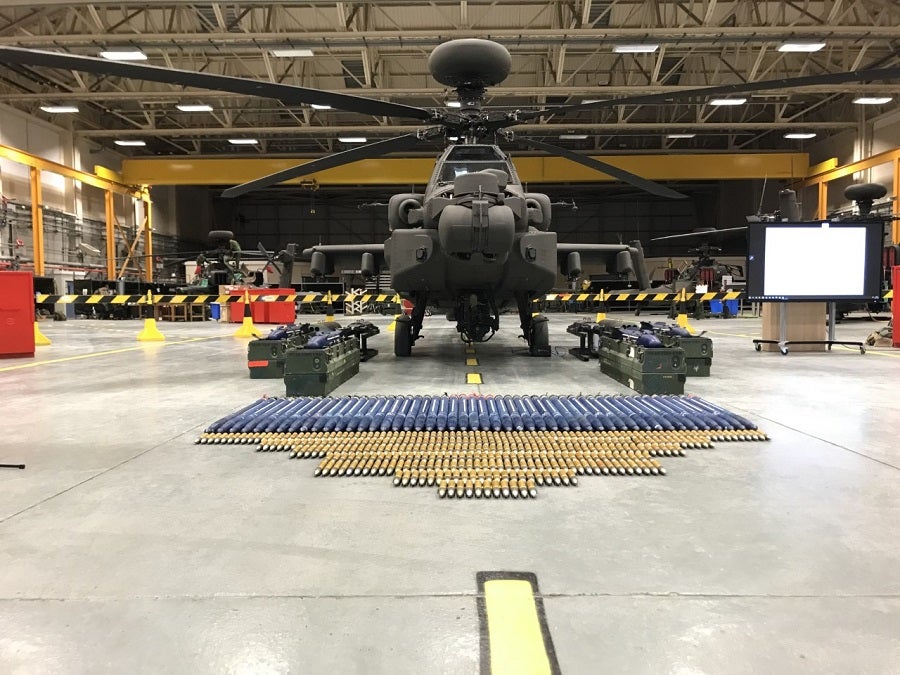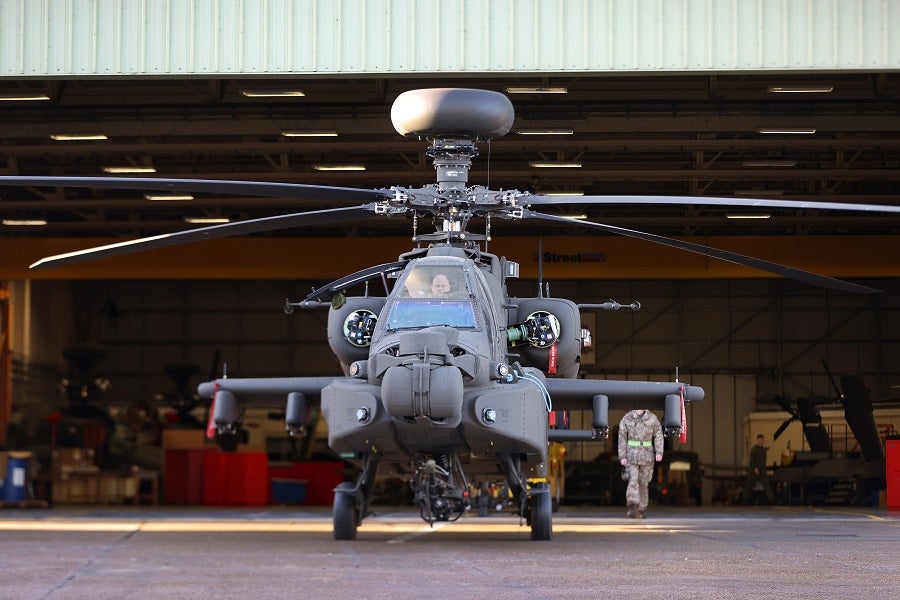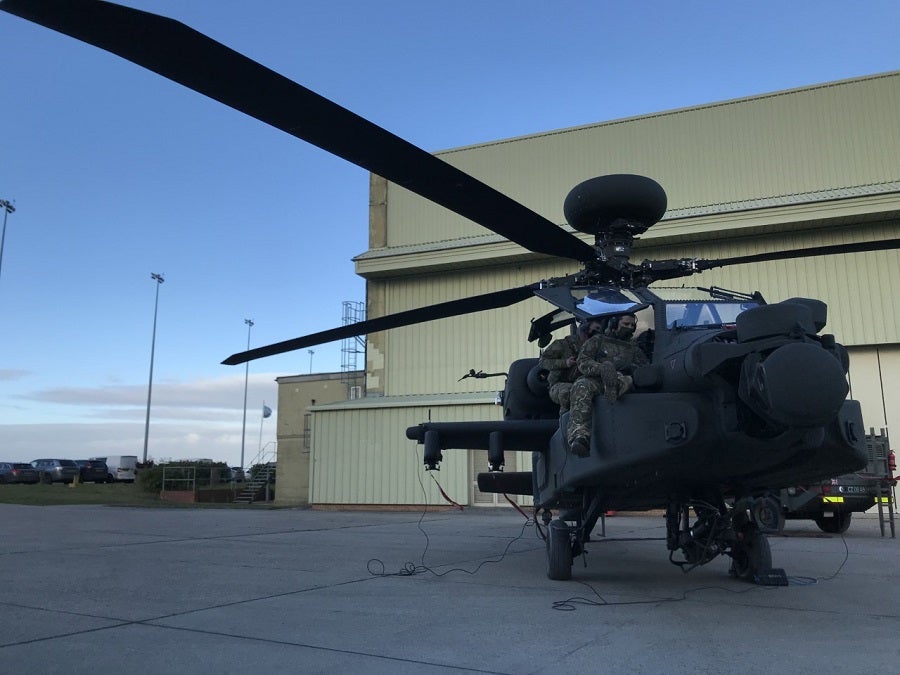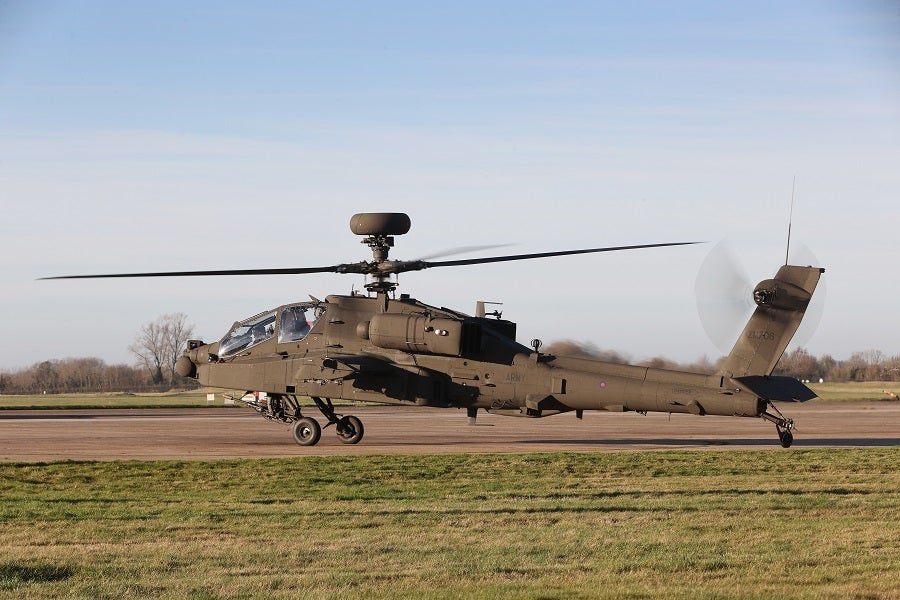
The British Army showcased the new Apache models and Boeing training facility with the presence of the UK Minister for Defence Procurement Jeremy Quin on 20 January 2022.
Wattisham Flying Station took delivery of 14 of the new aircraft in recent months, with 36 more due to arrive by summer 2024.
The new models have improved sensors and lethality, upgraded weapons systems and heightened communications compared to the Mark 1. The new Apache also boasts a top speed of 300kmh (186mph).
Test flights by the British Army are underway, with a boost to aerial capability anticipated early next year when the helicopters are expected to reach operational capability. The AH-64E variant is set to replace the Apache AH Mark 1, which reaches its out of service date in 2024.
The procurement of the new Apaches was announced in 2016. It reinforces the UK MOD’s ambitions laid out in the Defence Command Paper and the recent Future Soldier announcement to enhance the British Army’s capabilities.
A 20-year agreement has been signed with Boeing Defence UK to maintain and support the new fleet. With £288m confirmed for the first pricing period in place until July 2025, the agreement will support more than 200 jobs, including more than 165 at the Army Aviation Centre Middle Wallop and 45 at Wattisham Flying Station.
How well do you really know your competitors?
Access the most comprehensive Company Profiles on the market, powered by GlobalData. Save hours of research. Gain competitive edge.

Thank you!
Your download email will arrive shortly
Not ready to buy yet? Download a free sample
We are confident about the unique quality of our Company Profiles. However, we want you to make the most beneficial decision for your business, so we offer a free sample that you can download by submitting the below form
By GlobalDataThe contract includes the delivery of three Longbow Crew Trainer simulated devices for the E model. Two of them are already in the UK. The first was declared ready for training at the end of 2020 and the second is currently undergoing testing and installation.

The third and final is scheduled to be delivered in 2022. Situated with front-line Army Air Corps Apache squadrons, the devices will play a key role in transitioning the crews to the new Apache variant.
When asked about the significance of the procurement of the aircraft with respect to the MOD’s Multi-Domain Integration aspirations, Jeremy Quin told Global Defence Technology: “If you look at the capabilities of the E model compared to what it’s replacing, the extra the parity, the extra defensive suites, the ability to be utilised from the deep and to ensure we have an anti-climactic battle; all of that is absolutely critical and plays exactly into what we’ve been doing through the integrated review.
“It is a sign that modern technology comes in that is more lethal, is more effective and it has that effective deterrence.”
Flying the new Apache
The AH-64E is a multi-role combat helicopter with integrated avionics and weapons, as well as advanced digital communications to enable real-time, secure transfer of battlefield information to air and ground forces.
Apache pilots have to go through an additional six-week course before they can fly the AH-64E, operations officer and pilot of the 662 Squadron Major Tom Anstey said.
With a Longbow radar placed above the main rotor blades, the new models can detect 256 potential targets at once, prioritising the most urgent threats within seconds, up to a range of 16km (10 miles) away. Establishing target priorities happen before take off during a 4-5 hour preparation process that ground crew, engineers and pilots conduct.
US Army exchange officer and Apache pilot Jimmy Webb said: “Fighting the new Apache vastly changed. There are software upgrades with the new kits such as AAG [Air-to-Air/Air-to-Ground] receiver, manned-unmanned teaming (MUMTs), all the different radio fits, we’ve got additional SATCOM and different private network and data sharing.
“All of that is increasing the speed in which we can share and receive data from other people and that allows us to do our job quicker, to be more effective and more lethal.”
The aircraft will be able to conduct MUMT missions in the feature, meaning that Apache aircrew will be able to connect not only to other Apaches and crewed aircraft, but to uncrewed aerial systems (UAS) as well. By connecting to UAS cameras and sensors, Apache operators’ situational awareness will increase.
The new information and functions mean the number of tasks a helicopter crew will need to heed attention to rises, but with digitalisation and automatic data processing, some other, older tasks are carried out autonomously.

AH-64E maintenance
The first couple of Apache AH-64Es arrived in the UK from the US on 26 November 2020. But the US began using the variant in 2011 and it has been designed and equipped to offer common configuration.
Most British Army personnel working with or operating the AH-64E receive training from their US counterparts either in the US or in the UK.
Crew chief Petty Officer Stuart Isaksen is on an exchange from the Royal Navy, currently based at Wattisham, to oversee and manage the engineering work and the handover of aircraft from maintenance to flying duties.
He went to the US on the first training course in the summer of 2020, but a constant flow of engineers followed in order to ensure the supply of qualified engineers.
He said: “This platform is now even easier to maintain [than the Mark 1] and there’s a lot of considerations and feedback between ourselves, Boeing and procurement.”
A large amount of the parts from the Mark 1 are used in the new models, which reduces production costs and aims to be more environmentally sustainable.
“There are components which are interchangeable between the two models. Life components, for example, can only fly 1000 hours,” Isaksen added.
“If we sent an airframe across to America and that had only flown 50 of those 1000 hours, then that component would be suitable to be fitted to the new aircraft with the correct procedures of life-tracking.”
The new engines, drivetrain, larger main rotor blades and avionics will deliver a significant boost in the aircraft’s performance, but it also changes the aspects of maintenance and operations.
“The avionics is probably the most significant change within the platform,” said avionics supervisor Corporal Craig Veryard.
“It’s a complete upgrade of what was previously on the Mark 1 in terms of the capability of the radar, sighting systems, even the general computing system and radios. Everything has changed and is completely the next evolution in its capability.”








